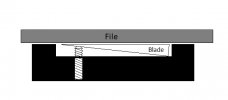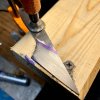- Joined
- Sep 29, 2008
- Messages
- 10,394
I'm prototyping some ideas and thought I should start with as simple a set of tools as possible. Cutting a primary bevel with a file felt very simple. Having spent some time roughing a bit of this out (it's nowhere near finished even roughly, view the picture with that in mind) I thought I could list what I've been doing and see if there are any tips or recommendations for adjusting things.
I started by bluing everything up with a sharpie and scribed a line 0.02" back from the rear side. I think that for a small single grind knife I could go thinner, but I didn't want to overshoot by much if at all. I then laid out a less critical but somewhat parallel line where I think the primary grind should end.
Work holding is an open question. I didn't have anything easily on-hand, so I put a screw in a 2x4 as a stop and a clamp on the other end. The 2x4 then went into a bench vise. I imagine there are far better ways to accomplish this and will happily take suggestions.
I started filing at a fairly steep angle and went until I was close to meeting the scribe line. I cleaned everything off, put some Tap Magic on (can't hurt right?), and started filing at a more in-between angle making my way up the primary grind. Periodically I would stop, card the file, wipe things down a little, and put some more blue on to make sure I was cutting what I thought I was cutting.
Now some questions. The grind is not flat. I can prove the grind is not flat because I went back and hit it with an extra coarse DMT stone for about 10 minutes. That's the "nice" scratch pattern you see. The curve is more pronounced on either end, the heel and the tip, but it is also slightly convex from the top to the edge. Is there a better way to be more "flat" right off the file? Or is this something I can only control for so much (save a jig) and I should plan on coming back with sandpaper and a flat reference?
Scribing and layout. The increments I'm measuring here are not very large. I went very light with a pair of calipers to set the edge line and didn't feel good about it in the slightest. Is there a better way to scribe or mark small distances? What about parallel offsets?
Material removal. I occasionally would wipe everything down and look at what was cut and where I felt I should be cutting next. Bluing everything back up occasionally helped with focus that, and helped keep me from cutting beyond the lines. With the two lines (top of primary grind line, edge line) I don't see how I could mess things up to a state where it isn't salvable as long as nothing has been cut past those lines and the file is still perpendicular. Am I wrong?
Any other general advice I'm happy to take as well.

I started by bluing everything up with a sharpie and scribed a line 0.02" back from the rear side. I think that for a small single grind knife I could go thinner, but I didn't want to overshoot by much if at all. I then laid out a less critical but somewhat parallel line where I think the primary grind should end.
Work holding is an open question. I didn't have anything easily on-hand, so I put a screw in a 2x4 as a stop and a clamp on the other end. The 2x4 then went into a bench vise. I imagine there are far better ways to accomplish this and will happily take suggestions.
I started filing at a fairly steep angle and went until I was close to meeting the scribe line. I cleaned everything off, put some Tap Magic on (can't hurt right?), and started filing at a more in-between angle making my way up the primary grind. Periodically I would stop, card the file, wipe things down a little, and put some more blue on to make sure I was cutting what I thought I was cutting.
Now some questions. The grind is not flat. I can prove the grind is not flat because I went back and hit it with an extra coarse DMT stone for about 10 minutes. That's the "nice" scratch pattern you see. The curve is more pronounced on either end, the heel and the tip, but it is also slightly convex from the top to the edge. Is there a better way to be more "flat" right off the file? Or is this something I can only control for so much (save a jig) and I should plan on coming back with sandpaper and a flat reference?
Scribing and layout. The increments I'm measuring here are not very large. I went very light with a pair of calipers to set the edge line and didn't feel good about it in the slightest. Is there a better way to scribe or mark small distances? What about parallel offsets?
Material removal. I occasionally would wipe everything down and look at what was cut and where I felt I should be cutting next. Bluing everything back up occasionally helped with focus that, and helped keep me from cutting beyond the lines. With the two lines (top of primary grind line, edge line) I don't see how I could mess things up to a state where it isn't salvable as long as nothing has been cut past those lines and the file is still perpendicular. Am I wrong?
Any other general advice I'm happy to take as well.



